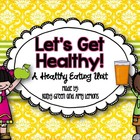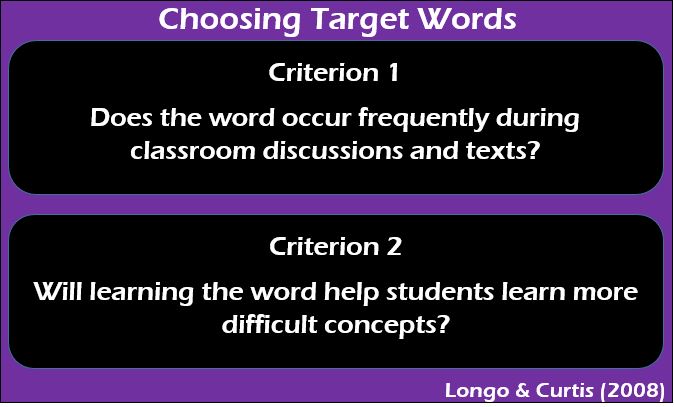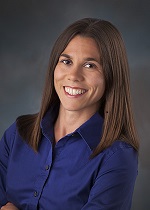I’m really excited to be featuring Dr. Karen Dudek-Brannan as part of a new monthly series on my blog. Each month, I am asking an SLP expert to share their specialized knowledge of how they do therapy with us. Karen is a speech language pathologist who specializes in language disorders and metacognition. If you have ever wondered how best to target language or vocabulary skills, you are definitely going to want to check out her blog. She has really useful treatment ideas AND some amazing freebies for followers.
Cracking the Code: The Vocabulary Solution for SLPs
If you’re an SLP working with the school-aged population, you’ve probably had countless referrals for students with vocabulary delays. More often than not, these students struggle across the board in school.
When these kids qualify for services, everyone on the IEP team is happy….because now you’re going to fix them…right?
This is where many of us get stuck. When these students end up on our caseloads, we have so much ground to cover and so little time to do it. Where do we even start?
I have an answer for you. But before I share it, let’s think about why we hit this wall.
There is a problem, and its name is Matthew.
The Matthew Effect: The rich get richer and the poor get poorer.
Keith Stanovich (1986) described the Matthew effect as it applies to learning vocabulary, naming it after the following bible verse:
“For whoever who has will be given more, and they will have an abundance. Whoever does not have, even what they have will be taken from them.” Matthew 25:29
The Matthew Effect is the phenomenon that occurs when students with stronger language skills learn words at a greater rate because they easily make connections with prior knowledge. They also tend to read often and more effectively, which means they have more exposure to sophisticated language.
Students with weaker skills have less background knowledge to relate to new concepts and weak reading comprehension skills. The knowledge gaps continue to widen because those who have less (vocabulary) gain less over time.
For those of us trying to close this gap, the task can be daunting.
The Game Changer: Tier 2 Vocabulary
Beck, Mckeown, and Kucan (2002) changed the way educators think about vocabulary instruction when they described a 3-Tiered framework for categorizing words. Here is a graphic explaining the model:

The theory behind this framework is that educators can’t directly teach all the words kids need to know. Instead, they need to prioritize and teach concepts that give them the biggest bang for their buck.
But for SLPs there is a catch…
The 3-tiered framework was originally designed for teachers who have 40-50 minutes a day to teach lessons. SLPs don’t have this much time, so prioritizing words into three tiers isn’t enough. It’s not feasible for SLPs to cover every word in each unit-even when focusing on Tier 2.
Another issue is that curricular materials and general education instruction are based on grade-level standards for the masses. What we do in therapy is different because it should be tailored to an individual’s unique needs.
The Solution: Prioritize and Individualize
In order to apply Beck et al.’s 3-tiered model to our therapy, we need to consider another framework. This model was developed by Longo and Curtis (2008), who identified two criteria to use when identifying word targets:
- Does the word occur frequently during classroom discussions and texts?
- Will learning the word help students learn more difficult concepts?

Longo and Curtis developed these questions for teachers, but considering these criteria along with the 3-tiered model can help us prioritize by selecting words relevant to the curriculum, and individualize by choosing words in line with our students’ abilities. If you can answer “Yes” to both questions for a particular word, you’ve identified it as a potential therapy target.
Tier 1 words occur often, so they meet the first criterion (word occurs frequently during classroom discussions and texts). For the majority of students, Tier 1 words do not meet the second criterion (learning the word will help learn more difficult concepts) because students have already mastered them. Using Beck et al.’s framework alone, we would stop here and assume we do not need to target these words.
This isn’t always the case for students with delays, because we can’t assume they know the “easy” words. For some students, learning these words is necessary for them to learn more difficult concepts if they haven’t mastered them yet. This means Tier 1 words would meet criteria for certain students if we consider the students’ abilities rather than curricular standards alone.
While severe students may need work on Tier 1, it’s likely we will spend the majority of our time working on Tier 2 words. These words will almost always meet Longo and Curtis’s criteria because they are frequently occurring and difficult. When choosing Tier 2 words, it makes sense to start with the words expected at your student’s grade level. To address Longo and Curtis’s first criterion, choose 1-3 per week as therapy targets that will occur most often in the classroom. Consider the second criterion (learning the word will help learn more difficult concepts) to individualize your therapy. In other words, pick the words out of the curriculum that are difficult for your particular student, because these may be the concepts holding them back from making connections with more difficult material. I’ve created these lists of Tier 2 words organized by grade level you can use as a starting point.
As a general rule, Tier 3 words don’t occur frequently enough across contexts to be a high priority, but there may be exceptions if your student is really struggling with a particular concept.
We may not be able to wave a magic wand and fix gaps in vocabulary, but we can be purposeful in what we choose to target so we can make the greatest impact possible.
You can get more information about choosing target words in language therapy and free Tier 2 word lists for SLPs in Are you an SLP working on vocabulary? If so, read this first.
Bio
 Dr. Karen Dudek-Brannan, Ed.D. CCC-SLP, has been a practicing speech language pathologist since 2004, and has worked in the schools and medical settings with adults and children, has supervised clinical students, and has taught college courses in Special Education and Communication Sciences and Disorders. She currently works in the school systems and runs Dr. Karen Speech and Language, a website with innovative resources for clinicians treating language disorders with an emphasis on metacognition.
Dr. Karen Dudek-Brannan, Ed.D. CCC-SLP, has been a practicing speech language pathologist since 2004, and has worked in the schools and medical settings with adults and children, has supervised clinical students, and has taught college courses in Special Education and Communication Sciences and Disorders. She currently works in the school systems and runs Dr. Karen Speech and Language, a website with innovative resources for clinicians treating language disorders with an emphasis on metacognition.
References
Beck, I.L., McKeown, M.G., & Kucan, L. (2002). Bringing words to life: Robust vocabulary instruction. New York, NY: The Guilford Press.
Fisher, D., & Frey, N. (2008). Word wise and content rich: Five essential steps to teaching academic vocabulary. Portsmouth, NH: Heinemann.
Justice, L. M. (2012, July). Enhancing vocabulary practices for children: Promoting academic language in clinical interventions. American Speech-Language and Hearing Association. Lecture conducted at the ASHA Schools Conference, Milwaukee, WI.
Longo, A.M., & Curtis, M.E. (2008). Improving vocabulary knowledge of struggling readers. The NERA Journal, 44, 23-28.
Stanovich, K. E. (1986). Matthew effects in reading: Some consequences of individual differences in the acquisition of literacy. Reading Research Quarterly, 21, 360-406.


This is an amazing post. I’ve now subscribed to Dr. Karen’s blog as well. While I enjoy a fluffy speech blog as much as the next SLP, I was thrilled to read so many practical, RESEARCH-BASED practice recommendations and ideas. Thanks so much for the introduction. I can’t wait to see who your next expert is!
I love her articles too! Thank you so much for your feedback-I am so glad to hear what you are looking for in blog posts.